Graphic design is an excellent career path that is completely aligned with the careers and skills of the 21st century.
However:
With so many education options and advice on graphic design, it can be very difficult to grasp how to become a graphic designer.
Having taught graphic design in college for the past 10 years, I have identified the most important steps to become a graphic designer.
So:
How to become a graphic designer? To become a graphic designer, you need to follow a repetitive process that includes the following action steps:
- Study and understand graphic design principles
- Develop competent skills in pixel and vector graphics software
- Practice graphic formats, such as logos, business cards, flyers, and newsletters
- Develop a visual vocabulary by looking at other people’s work
- Build a portfolio of your best work as you continue to progress in each step
Of course, there’s more to becoming a graphic designer than these 5 steps.
In this complete guide, I will give you actionable answers that will put you on the right path to become a graphic designer.
Let’s begin.
MY NEW ONLINE COURSE
Thinking Like a Designer
Learn my proven method to finally understand the rules of any design and jumpstart your path to become an effective graphic designer
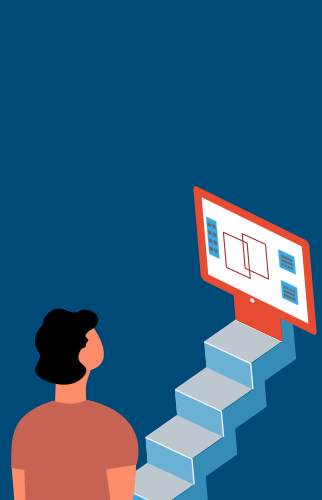
How to Become a Graphic Designer
Over the years, I have taught graphic design to hundreds of students with no experience, and some have successfully quick-started their design careers after only one semester.
Most leave the class having learned enough design principles and skills to feel confident about their next steps and keep on learning and growing.
This is exactly where you want to be.
BUT:
They all have followed a method in which they are studying design principles, practicing software skills, learning the specifics of graphic formats, and looking at other people’s work progressively.
The following diagram illustrates what I mean:
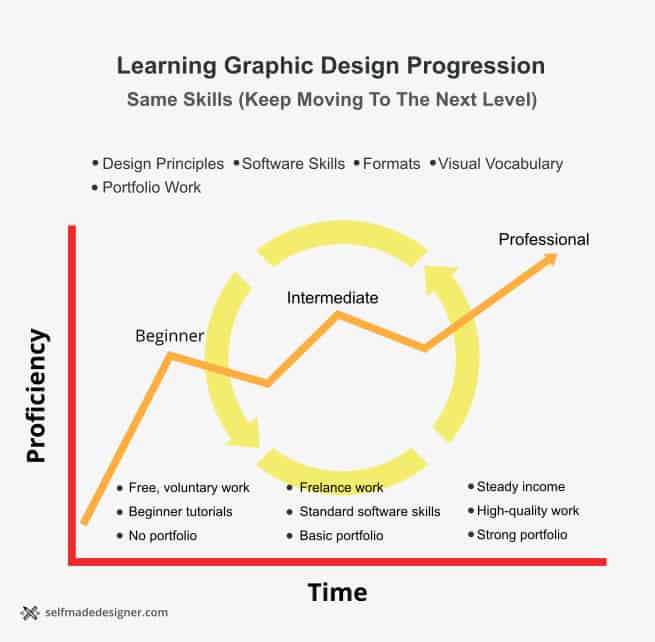
As you can see, every level focuses on pretty much the same areas.
However, as you practice and put in the time, you move on to another level in which these same areas and actions become more challenging.
My point is this:
The main aspects of graphic design are all part of the process. You just have to practice, study and get better at them.
Let’s look at the process in more detail:
1. Study and Understand Graphic Design Principles
To become an effective graphic designer, you need to understand the principles of graphic design. I cannot stress this enough.
As I tell my students, you can become an expert at clicking buttons in pixel and vector graphics software, but if you don’t know how to apply the principles of design into your work, you will not produce professional results.
The better you get at applying graphic design principles to your work, the more you will progress at becoming a professional graphic designer (as opposed to an amateur one).
2. Develop Competent Skills in Pixel and Vector Graphics Software
Knowing design principles is only part of the graphic design equation.
In order to be successful, you need to actually be able to render visuals that will communicate a message in a compelling, pleasing way.
By using graphic design software effectively, you are able to manipulate visuals for communicating ideas and messages to an audience.
The only way to learn to use design software is by starting with basic projects and progressing to more difficult ones with consistency.
The more design problems you encounter, the more problems you can solve. The more you learn to solve problems, the more experience you gain.
Think about it:
What skills would you have after 1 hour of using graphics software? 25 hours? 1,000 hours?
The more time you put in, the more experience you will have earned. The more experience you have, the more effective and comfortable you will be as a graphic designer.
The good news is that you don’t need to spend a single dime. There is AMAZING and FREE graphic design software available to you, such as Gimp and Inkscape.
So, start with a graphic design project right now.
3. Practice Graphic Formats
Now that you have started to learn design principles and use graphics software, you need to start learning the basic formats.
You know the ones:
Logos, icons, badges, flyers, business cards, etc.
My advice is that you begin mastering the logo first, because logo design teaches you a great deal about design principles.
Also:
Logos are encompassed in all other design applications. That is, you find logos within business cards, websites, and flyers.
A flyer or a newsletter is another excellent design application that will teach you much about layout.
So:
Start creating a logo for a family member or start to design a newsletter for your local community organization.
These real design projects will allow you to learn and gain experience.
4. Develop a Visual Vocabulary (Look at Other People’s Work)
From the beginning, immerse yourself with the work of accomplished graphic designers and draw inspiration from them.
Ask yourself some questions:
- What are the characteristics of their work?
- What makes it beautiful or effective?
- How do they use design elements, such as lines, colors, and shapes?
The more you look at good examples of graphic design, the more you will understand the principles of design. In addition, you will start to develop your own style by understanding what you like.
You can start looking at other people’s work on a site like Behance or start following graphic design accounts on Instagram.
5. Build a Portfolio of Your Best Work as You Progress
A graphic design portfolio is a selection of pieces that showcases your most refined work.
Now that you have a system in place for learning and practicing, you will naturally start producing work that, in time, will showcase your skills, style, and experience in graphic design.
Today, digital portfolios are an excellent way to show your work.
A Wix website, an Instagram account, or a Behance page can all be excellent ways to build a portfolio. These portfolio examples will give you a good idea of how a digital portfolio looks like.
Now, realize this:
We all sucked in the beginning!
This means that it will take time and effort to build a competent portfolio. However, you could start right now.
In fact, there will be multiple “versions” of your portfolio, which will improve over time.
Even George Bokhua, one of my favorite contemporary graphic designers, said this about his early work:
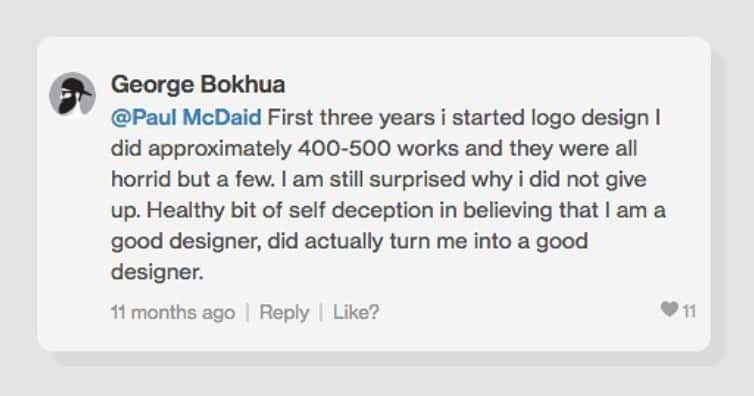
Becoming a Graphic Designer: FAQ
Now that you have a clear idea on how to become a graphic designer, let’s look at some frequently asked questions about becoming one:
Is Graphic Design Hard?
This is a very reasonable question:
Is it hard to become a graphic designer? Becoming a graphic designer is not hard if you understand the basic knowledge and skills you need to master as a designer, have dependable and quality resources for study and reference, and develop consistency for practicing and improving from the very beginning.
However, IT WILL TAKE TIME. It’s a fact you need to accept off the bat.
Let me explain:
You can’t become anything without sweat, consistency, and persistence. Period.
At first, you will probably suck at graphic design. But if you stick with it, you will slowly but surely get better.
So, start right now.
The trick is to continue practicing, figuring out problems, studying, and learning to understand what makes up good design.
You need to be very persistent and patient.
I look at some of my fist logos and I am ashamed. They are absolute crap!
However, I got better with time, finally getting a firm sense of what’s good design and what isn’t.
Keep in mind that you will not suck for the entire time you are learning.
You will go through different levels and each level will bring you new projects, opportunities for revenue, challenges, and, most importantly, learning experiences.
Also:
Learning on your own doesn’t mean that you’re not getting “formal” education.
You will learn from books and great quality courses, and also from actual designers on the internet.
In sum:
You can learn to design in different ways, and it all boils down to the time spent on the actions that matter the most:
- Learning design principles and theory
- Practicing with graphics software
- Getting involved in as many design projects as possible (go do a postcard for your mom, a business card for your brother, a logo for a friend. etc.)
When I look back at my own process of becoming a graphic designer, I don’t think it was hard. I just see that it took time.
What Is the Graphic Design Profession?
Understanding what graphic design is will give you a good idea of how hard learning graphic design would be for you. This is the first step in knowing whether you can actually stick with it long enough to become a designer.
What is graphic design? The profession of graphic design is concerned with the strategic communication of concepts, ideas, and emotions through visual means.
In other words:
Graphic designers are visual communicators who create effective solutions for communicating to an audience through visual representations.
Sounds cool, right?
It is. But the task of graphic design entails much more than simply creating graphics on a computer.
Graphic designers are communicators and their skills go beyond the graphic aspect of the profession.
What Skills Do You Need to Become a Graphic Designer?
A graphic design career entails much more than just sitting in front of a screen drawing or retouching photos.
In fact, design is a very dynamic career in which you need to engage in different processes before you even start to design.
As visual communicators, graphic designers must be good at planning, strategizing, researching, and evaluating information.
In general, graphic designers must become proficient in the following skills:
Research
Designers must be good at evaluating and investigating ideas, brands, and organizations in order to produce visual products that are appropriate, unique, and effective at communicating intent (a logo, for example, entails a lot of research before even sketching a design).
Theory
Graphic designers must have a solid grounding in the theory and fundamentals of design. They are always learning and fully understand the principles that underlie both good design and communication.
Communication
Designers understand the fundamental principles of communication and how they apply to visual language. For example, they know how to appeal to people’s emotions, how to apply the psychology of color, and about clear channels of communication.
Visual Elements
Designers understand what works visually and what does not.
They have developed a sense of beauty and functionality through experience, observation, and modeling their favorite designers.
Apart from these macro-skills, graphic designers at least must master the following visual skills:
- Color
- Layout
- Composition
- Typography
- Proportion
If you want a more extensive list of skills, check out the O*Net website (from the US Department of Labor), which compiles data from multiple graphic-design related job titles:
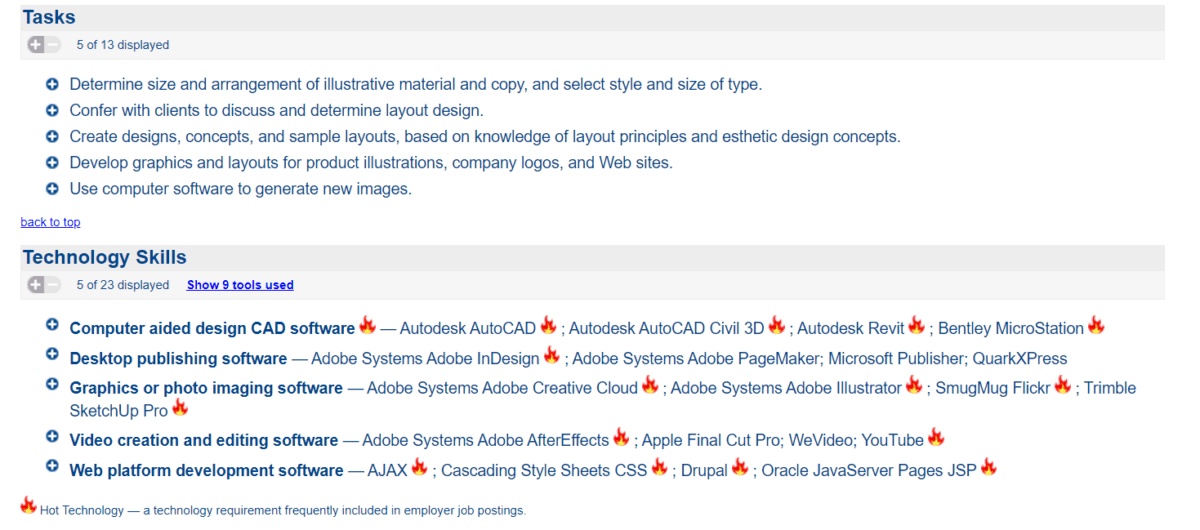
Is Graphic Design A Good Career?
As with any job in the creative economy, graphic design continues to be a career choice with good prospects.
Think about it:
Today, graphics and visual information are at the center of everything we do and consume. Just about any industry, from tech to education to health to advertising, relies on images to convey messages.
This is because graphic design is all about the communication of information in visual terms.
However, this means that a lot of people want to become graphic designers. In other words, there is competition in the field.
Still, there are many graphic design job openings because demand is so great. For example, if you look at current job openings on the job search website Jooble for remote graphic design jobs, you’ll see that there are more than 600,000 vacancies right now.

Job Vacancies
Furthermore:
You don’t have to have a graphic designer position to actually make money as designer. You can work freelance through marketplaces such as Fiverr, for example.
You can even sell your own designs on physical products, such as stickers, and sell them on marketplaces such as Etsy, which specialize in goods made by artists and makers.
In other words: There are many routes you can take in order to make money as a designer. You just have to be creative.
How Much Do Graphic Designers Make? (Graphic Design Salaries)
Graphic design salaries are competitive in a profession that qualifies as highly-skilled labor.
According to data from the US Bureau of Labor Statistics, the median annual salary for a graphic designer was $53,380 in 2020, with higher average salaries (above $63,000) in states such as Washington, Massachusetts, New York, and California:


And there’s something else:
Related fields, such as web development, have higher average salaries (above $75,000 per year) and are growing at an above average rate.
This doesn’t mean that you now have to become a programmer.
It means that, as you learn graphic design, you will benefit from learning skills that directly relate to graphic design for the web.
The more you combine graphic design with the field of web design, the better your chances at succeeding in the field.
Here’s the good news:
You don’t necessarily have to know code to design for the web, as there are many aspects of web design that don’t require complex computer science skills.
Do You Need a Degree To Become a Graphic Designer?
You definitely can become a graphic designer without a degree.
Now, don’t get me wrong:
School or university education can help you in achieving a career in graphic design. The thing is, I truly don’t think it’s required for your success.
Let’s analyze this:
These are the pros of getting a graphic design college degree:
- It can give you a clear path as to what you need to learn and the skills you must master.
- It can provide you with expert guidance and assistance from a professional along the way.
- It could help you find a job or internship experience right out of school through special university programs.
But don’t be fooled:
I’ve seen many recent graphic design graduates who are no better, or worse, than self-made designers.
In addition, school can be expensive, will take time, and results are not guaranteed.
To give you perspective, according to the report Trends in College Pricing 2020, by the College Board, average out-of-state tuition and fees at public four-year universities were $27,020 in 2020-21, a .9% increase from 2019-20.
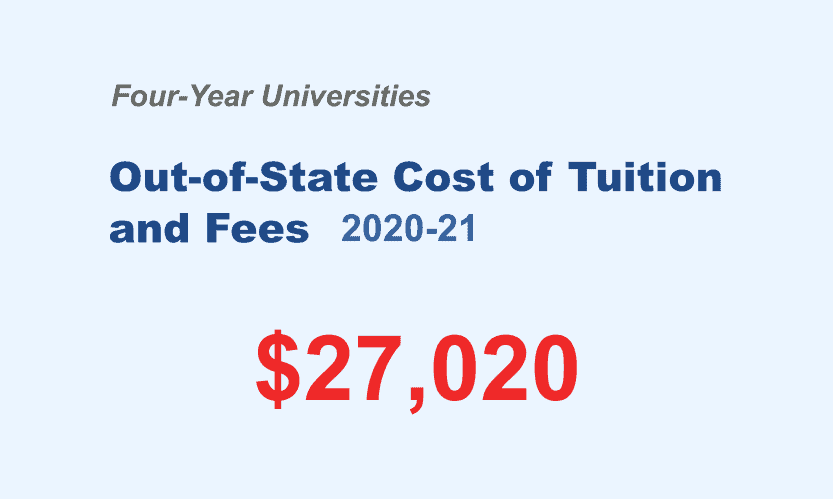
On the other end of the spectrum, platforms such as Udemy, Skillshare, Domestika, and Creative Live, have an extensive list of graphic design courses, which range from a couple hundred dollars for a course to memberships of about $40 per month.
This means that a graphic design degree is an investment of time and money. But some investments are more risky, time consuming, and costly than others.
In sum:
A graphic design degree makes sense if you:
- Need pressure and external motivation to get things done.
- Have the economic resources to pursue it.
- Need external validation factors (such as grades) to keep improving.
- Need someone to tell you what to do to get organized.
- Need constant external pressure to accomplish tasks and assignments.
- Are in no hurry to become a graphic designer (you will have to take courses other than graphic design, go at the pace of the curriculum, etc.).
If you are diligent with a degree, you can actually end up with a great portfolio, which is, ultimately, the only variable that will land you a graphic design job, period.
But a self-made graphic designer could also accomplish a reasonable portfolio, probably before the four-years it takes to get an undergraduate degree, if the person is diligent and passionate about it.
In the end, it boils down to this:
The path you take depends on many factors, such as your motivation level, economic resources, time restrictions, and your eagerness to become a designer.
Can Anyone Become a Graphic Designer?
Now that you have some understanding of what graphic design is, you’re probably asking the big question:
How do you know if you have what it takes to become a graphic designer?
Judging from my own learning journey and my experience teaching college-level graphic design, over and over I’ve seen certain characteristics that separate my most successful students from the least successful ones.
Answer the following “quiz:”
- Do you have at least a little bit of talent?
- Are you a creative person or do you feel the need to create something?
- Do you have a need to communicate something?
- Do you have a passion for art and design or enjoy other people’s artwork or creations?
- Do you know what you like in terms of design (how things look, feel, or what they represent)?
If you can truly answer “yes” to at least 3 of the previous questions, you probably have the right aptitude to pursue graphic design.
But no so fast:
This in itself is no guarantee that you will succeed.
Ultimately, success will always be determined by your level of commitment in terms of studying design principles, practicing, and getting involved in actual design projects.
However, understanding whether you fit within this description at least will give you some idea if you would enjoy graphic design as a line of work.
Conclusion: It’s All About The Timeline
Learning graphic design is not a sprint, it’s a marathon. I am still on mine.
If this is what you want, your only regret will be that you didn’t start any sooner.
So start right now: Get a book, download free software, and start on your very project.
And, of course, you can follow selfmadesigner.com!
MY NEW ONLINE COURSE
Thinking Like a Designer
Learn my proven method to finally understand the rules of any design and jumpstart your path to become an effective graphic designer

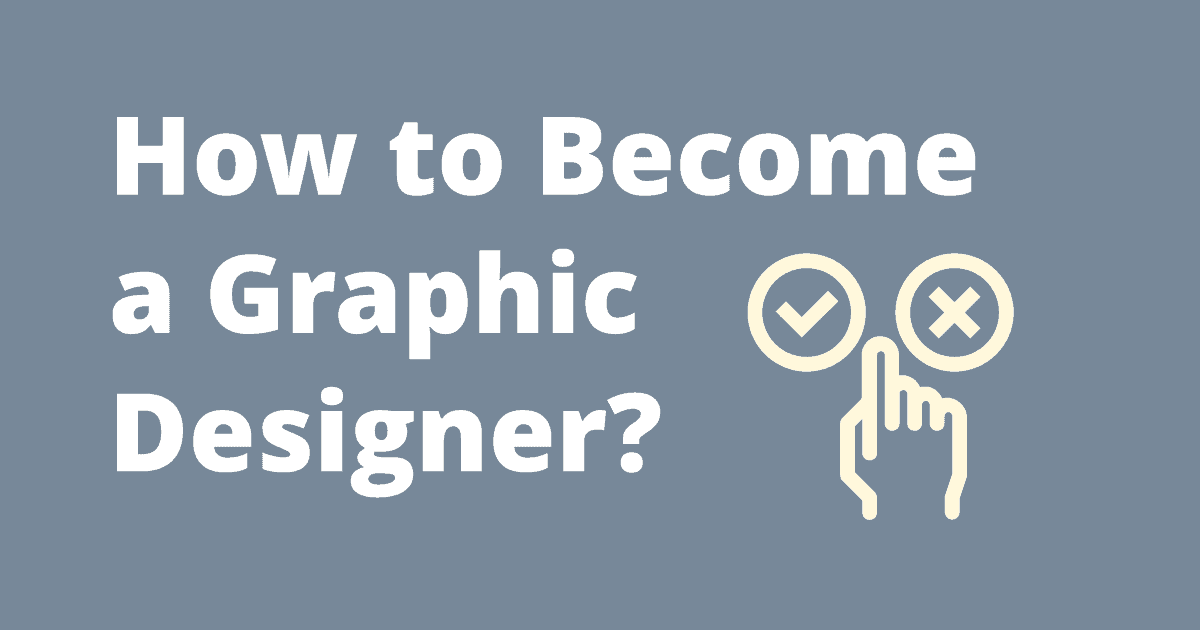

I am finally starting 11 grade. I don’t have a exact aim or what I want to be. To be clear don’t have a aim but the good part is I am eager to learn new things. I find about something and do research on it and gain knowledge. I wan’ t keep learning new stuff. I also really want to express what I feel but never able to talk about it to anyone. So this is my story. Can u help by telling me if I have what it takes to become a graphic designer.
Sujita:
Thank you for sharing. I hear many great aptitudes that would qualify you to be a graphic designer. You still have some time to decide, which is good. I would suggest you start testing out learning graphic design to see if it’s something you would commit to in the long term. Download Inkscape or Gimp, think of a project you would like to accomplish (a logo for your social media, a flyer, a poster for your bedroom, etc.) and start learning. There are a lot of resources in my website but also in places like YouTube. It’s time to test it out!
At 41 am I too old to pursue a graphic design degree and career? Taking in consideration the time it takes to have a successful career.
I hear ya, Travis. I’m 44 myself. But think about it this way: Changing careers is not an On/Off switch. It’s a transition over time. You can start with that transition right now, maybe first for the pleasure of learning something new and having a creative outlet, but as you continue other things might start to happen, like getting payed for some random work. As time passes, you would be building the experience and the work samples (portfolio) that would help you to actually transition. You could do this, depending how much time and effort you can apply, in only a couple of years, which isn’t that much in the grand scheme of things. Hope this helps. Thanks for sharing!
Hi Ruben, I liked that reply and the article too ( I’m in my 40s too); I rarely finish reading the whole article but this one caught my attention, because it contains honest and straight information.
I consider learning graphic design on my own, I used to draw when I was a kid, I like taking photos of nature, but I wonder if I can Actually make this transition in my career and work online on my own knowing that I’m not from USA nor from Europe.
Thank you again.
I’m 24. I started to dabble in graphic design when I was 13, creating layout for MySpace and creating eye popping profile pictures. It’s silly when I look back at those day but it also felt accomplishing. Throughout high school I designed shirts and logos for my high school and other clubs. I was surprised when people actually liked them. When I got to college I felt the pressure of the competition of being a graphic designer and stopped doing photoshop mainly because it is tedious work. I would of course still create wedding cards for my family and any other request they’ve asked. I’ve been thinking about going back into graphic design but I need a hard push. I work full time now in an office and sure I’m good at what I do now but sometimes I wonder what life would be like if I followed the graphic design route. Trying to work and juggle graphic design in isn’t the easiest task but after reading post from actual graphic designers and their experiences I think it would be worth it to attempt again.
I am a student in the Philippines and I’m currently not sure about what to take, I am in the 11th grade and want to start to choose a path that I would take, and currently, I enjoy thinking about working as a graphic designer
Chris Hulleza:
If your not sure that’s fine you still have time to figure it out. Just make sure to practice everyday and read up on articles pertaining to graphic design.
Such a nice blog on the whether becoming a graphic designer is hard or not. I love reading this blog and the great one I would surely recommend others to come over this article. Keep sharing such informative articles in future, will be appreciated. I really loved reading this article.
Hi! I am a 59 years old woman. I love art, craft, and design. First of all thank you so much for you honesty on the information given. I appreciated very much. I am not looking to be a graphic designer. I wanted to get knowledge of if because my son girlfriend just graduated as a graphics designer and she made it to be that only smart people can get that career. Just recently I ask her to make me a simple logo and the prices she gave me was from $100 up to $1000. Can you please tell me are this prices right? Thank you so much, and I will be looking forward to your reply. Maria
Thank you so much for your comment María. Logo pricing is tricky. They can range from $50 to millions of dollars. My take is that the price of a logo is determined by certain factors, such as (1) Experience and level of expertise of the designer; (2) the designer’s body of work or portfolio, (3) level of effort to be required (research, originality); and (3) profile of the brand for whom the logo is to be designed. So, I tell my students that their first logos will probably be free or close to free, since they need the experience to really understand the process. Then, they can start charging according to their previous outcomes, level of confidence, etc. A hundred dollars sounds fair for a beginner with professional-grade results. A thousand, on the other hand, sounds like design studio or advertising agency level pricing. I hope this helps!
Thanks a lot of to you. As a beginner of this sector when i read this blog it unrevealed some attitudes of me and i get many inspiration from it.
It is very helpful and important post. Thanks for sharing.
I’m in 10th grade and now I’m starting to seriously consider pursuing graphic design. I know you’ve answered whether Graphic design is hard or not but I just need to know specifically if the graphic design FEILD/INDUSTRY itself is competitive or hard to get into.
I’m In 10th Grade now and I’m starting to seriously consider pursuing Graphic design as a career.
I know you’ve already answered whether or not Graphic design is hard to get into but I would like to know specifically if the graphic design industry or the field itself is hard to get into. Thanks so much.
I am 19 years old but before now I so much admire people that knows how to design stuffs I like it whenever I see someone designing on system I will atlist sit close to the person for a while and wish how I would be a good graphics designer before going to school..I always wish you learn how to design when I was growing up and sometimes I will forget about it but recently the thought is still on my mind to go and learn graphics as a lady it’s will be helpful to me
I am 18 yrs and I am a science student though I have passion for drawing.please how do I know if I have the required attributes to become a graphic designer since am kind of new to this idea and it sounds great to me.i will really love to have an idea of it
Greetings, new subscriber! I’m a photographer who has dabbled in graphic design in the past, and I’m getting back into it now. Thanks for inspiring me
This is very helpful and informative post. Thanks for sharing.
hello,
i am 20 years old i AM studying civil egineering i am from pakistan i next semester autocAD will be added in my course but i want to make pocket money by graphic designing freelancing for myself as a student
kindly tell me which laptop with good specs that i should use
and kindly share the whole free course for graphic designing free lancing on fiverr and autocad
thak you.
I am in my 50s. I wanted to create something expressive for my adult daughter. thinking that a creative art piece might the say what I wanted it to say. Just couldn’t get to expressions.
Went in search and found this. I am thankful. It really peak my interest
I was also encouraged by those who have shared.
Thanks again this maybe something I would seriously go into.
Hi, thanks for this article!
I am 57 and have been a full time hand engraver for 20+ years. I have used photoshop elements, Corel draw, Inkscape, and now procreate at very basic levels to create design proposals and layouts that I engrave after they are approved.
I find that the creative process of design is getting more compelling than actually engraving it.
I love working with text, monograms, etc. but I don’t create “finished” art most of the time. During the pandemic I started writing haiku and pairing them with a picture from a library of photos primarily taken by my wife and daughter.
The good thing is that getting better at graphic design won’t hurt my engraving, but it might head me in a fresh direction. I will be thinking a lot about this! Thanks again!
Hi, I am 31 now and looking to change the carrier. I have never tried anything related to creativity work, I have drawn some but not as a professional. Just an adequate. So my friend is suggesting me to try graphic designing, which I replied to as I am not a creative person. But graphic designing is interesting and intimidating as well. The question I want to ask is how can I start from basic to be graphic designer. How can I improve my creativity skill or develop creativity skill.